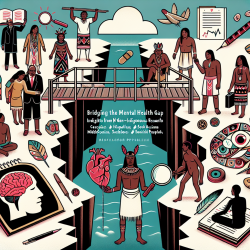Understanding the Mental Health Disparities Between Indigenous and Non-Indigenous Populations
The mental health landscape in Canada reveals significant disparities between Indigenous and non-Indigenous populations. A recent study titled "Explaining the gaps in psychological distress and suicidal behaviours between non-Indigenous and Indigenous adults living off-reserve in Canada: a cross-sectional study" sheds light on these differences and provides insights into potential solutions.
Key Findings from the Research
The study utilized data from the 2012 Canadian Community Health Survey — Mental Health, focusing on adults aged 18 and older. It highlighted that Indigenous people living off-reserve in Canada experience higher levels of psychological distress and suicidal behaviors compared to their non-Indigenous counterparts. Specifically, the mean psychological distress scores were higher among Indigenous people (16.1) compared to non-Indigenous people (15.1), with a significant difference in the prevalence of lifetime suicidal ideation (16.8% vs. 9.2%) and suicide plans (6.8% vs. 2.3%).
The Role of Socioeconomic Factors
One of the most compelling findings of the study is the impact of socioeconomic factors on mental health disparities. The research suggests that if the socioeconomic status of Indigenous populations were elevated to match that of non-Indigenous populations, the disparities in psychological distress and suicidal behaviors could be significantly reduced. For instance, the differences in psychological distress scores could decrease by approximately 25.7%.
Implications for Practitioners
For practitioners working in the field of mental health, these findings underscore the importance of considering socioeconomic factors when addressing mental health issues among Indigenous populations. Here are some actionable steps practitioners can take:
- Advocate for policies that aim to improve the socioeconomic status of Indigenous communities, such as income equalization and increased access to education and employment opportunities.
- Incorporate culturally sensitive approaches in mental health services to better address the unique challenges faced by Indigenous populations.
- Engage in continuous education and training to understand the historical and ongoing adversities that impact Indigenous mental health.
- Collaborate with Indigenous leaders and organizations to develop community-specific interventions that respect cultural contexts and needs.
Encouraging Further Research
While this study provides valuable insights, it also highlights the need for further research to explore other determinants of mental health disparities, such as cultural and historical factors. Practitioners are encouraged to engage in or support research initiatives that aim to uncover deeper insights into the mental health challenges faced by Indigenous populations.
To read the original research paper, please follow this link: Explaining the gaps in psychological distress and suicidal behaviours between non-Indigenous and Indigenous adults living off-reserve in Canada: a cross-sectional study.










